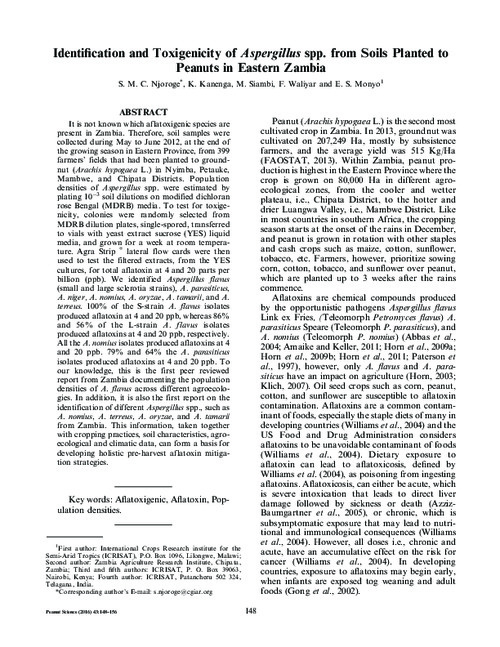Identification and Toxigenicity of Aspergillus spp. from Soils Planted to Peanuts in Eastern Zambia
Abstract
It is not known which aflatoxigenic species are
present in Zambia. Therefore, soil samples were
collected during May to June 2012, at the end of
the growing season in Eastern Province, from 399
farmers’ fields that had been planted to groundnut
(Arachis hypogaea L.) in Nyimba, Petauke,
Mambwe, and Chipata Districts. Population
densities of Aspergillus spp. were estimated by
plating 10 3 soil dilutions on modified dichloran
rose Bengal (MDRB) media. To test for toxigenicity,
colonies were randomly selected from
MDRB dilution plates, single-spored, transferred
to vials with yeast extract sucrose (YES) liquid
media, and grown for a week at room temperature.
Agra Strip t lateral flow cards were then
used to test the filtered extracts, from the YES
cultures, for total aflatoxin at 4 and 20 parts per
billion (ppb). We identified Aspergillus flavus
(small and large sclerotia strains), A. parasiticus,
A. niger, A. nomius, A. oryzae, A. tamarii, and A.
terreus. 100% of the S-strain A. flavus isolates
produced aflatoxin at 4 and 20 ppb, whereas 86%
and 56% of the L-strain A. flavus isolates
produced aflatoxins at 4 and 20 ppb, respectively.
All the A. nomius isolates produced aflatoxins at 4
and 20 ppb. 79% and 64% the A. parasiticus
isolates produced aflatoxins at 4 and 20 ppb. To
our knowledge, this is the first peer reviewed
report from Zambia documenting the population
densities of A. flavus across different agroecologies.
In addition, it is also the first report on the
identification of different Aspergillus spp., such as
A. nomius, A. terreus, A. oryzae, and A. tamarii
from Zambia. This information, taken together
with cropping practices, soil characteristics, agroecological
and climatic data, can form a basis for
developing holistic pre-harvest aflatoxin mitigation
strategies

